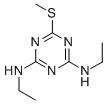Simetryn 西草净
Introduction: Simetryn is a triazine herbicide that is primarily used to control broad-leaved weeds and grass in paddy rice and other crops. It is absorbed through roots and foliage and inhibits photosynthesis. Like other triazine herbicides, simetryn is characterized by high persistence and toxicity.
Common name: Simetryn
Another name: GY-Bon; SIMETRYNE; Symetryne; Cymetrin; etc.
Chemical name: 2-chloro-2',6'-diethyl-N-(2-propoxyethyl)acetanilide
Empirical formula: C8H15N5S
Structural formula:

Mol. Weight: 213.30 g/mol
CAS No.: 1014-70-6
Specifications
Leading Simetryn supplier
Simetryn 95% TC
Simetryn 25% WP
Packing:
BULK PACKING
Powder: 25kg/Bag, 25kg/Drum, 50kg/Drum etc.
Liquid: 200L/Drum, 20L/Drum, 10L/Drum etc.
SMALL PACKING
Powder: 1kg/Alu bag, 500g/Alu bag, 200g/Alu bag, 100g/Alu bag, 50g/Alu bag, 15g/Alu bag etc.
Liquid: 5L/Drum, 1L/Bottle, 500ml/Bottle, 250ml/Bottle, 100ml/Bottle, 50ml/Bottle etc.
Customerized packing label
Simetryn FAO standard
Professional registration
HAZARDS IDENTIFICATION
Hazard statement(s)
H302 (100%): Harmful if swallowed.
H332 (31.94%): Harmful if inhaled.
H400 (100%): Very toxic to aquatic life.
H410 (100%): Very toxic to aquatic life with long lasting effects.
Precautionary statement(s)
P261: Avoid breathing dust/fume/gas/mist/vapors/spray.
P264: Wash ... thoroughly after handling.
P271: Use only outdoors or in a well-ventilated area.
P273: Avoid release to the environment.
P301+P312: IF SWALLOWED: call a POISON CENTER/doctor/... IF you feel unwell.
P304+P312: IF INHALED: Call a POISON CENTER/doctor/... if you feel unwell.
P304+P340: IF INHALED: Remove person to fresh air and keep comfortable for breathing.
P312: Call a POISON CENTER or doctor/... if you feel unwell.
P330: Rinse mouth.
P391: Collect spillage.
P501: Dispose of contents/container to an approved waste disposal plant.
Supplemental Hazard Statements: none.
MAMMALIAN TOXICOLOGY
Acute toxicity: 1) Acute oral LD50 for rats is >750 mg/kg. 2) Acute dermal LD50 for rats is >3100 mg/kg. 3) Acute inhalation toxicity LC50 (4 h) for rats is 4.88 mg/L. 4) Skin irritation: Non-irritating to skin (rabbits). 5) Eye irritation: Non-irritating to eyes (rabbits). 6) Skin sensitization for guinea pig: Not a sensitiser.
NOEL: (2 y) for rats 1.2 mg/kg/day. Other Not genotoxic.
ADI 0-0.025 mg/kg b.w.
Classification:
WHO Classification: III (Slightly hazardous)
EC Risk Classification: Xn - Harmful: R22; N - Dangerous for the environment: R50, R53
US EPA Classification (formulation): No consensus across products or no products available
ECOTOXICOLOGY
Effect on fish: Acute LC50 (96 h) for Rainbow trout is 7.0 mg/l. Effects on aquatic invertebrates: Acute EC50 (48 h) for Daphnia magna is 50.0 mg/l. Effects on algae: Acute 72 hour EC50 for Anabaena flos-aquae is0.0098 mg/l.
ENVIRONMENTAL FATE
Animals: DT50 in rats c. 10 h. Excreted in urine and faeces; two oxidative metabolic pathways. Plants: Selectivity and metabolism of simetryn reviewed.
Usage: Simetryn was introduced by Ciba-Geigy AG (now Syngenta AG). It is a triazine herbicide mainly used for broad-leaved weed and grass control in paddy rice and other crops.
Application: Biochemistry: Photosynthetic electron transport inhibitor at the photosystem II receptor site. Mode of action: Selective herbicide. Uses: Used in combination with thiobencarb to control broad-leaved weeds in rice.
| 






